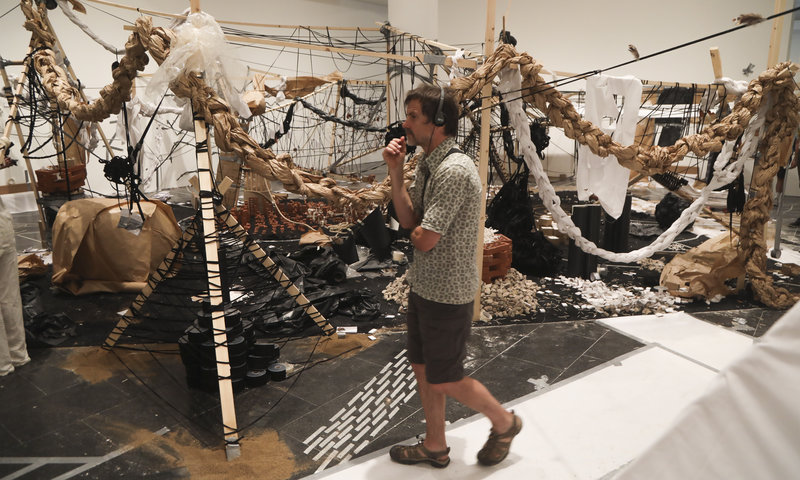Macba makes a call to the barricades
Barcelona’s Museum of Contemporary Art hosts work by Brazilian artist Cinthia Marcelle that aims to “disorganise the hierarchies and binary oppositions that pattern our daily interactions”
My creative process is based on the conviction that art is not above anything, nor is the artist above anyone else.” So says Cinthia Marcelle (Brazil, 1974), whose artistic career spanning two decades, including the highlight of representing her country at the 2017 Venice Biennale, is the subject of the exhibition, A Conjunction of Factors, running at Barcelona’s Museum of Contemporary Art (Macba) until January 8.
“It is one of the most exciting exhibitions that can be seen this season in Barcelona,” says the director of the museum in Plaça dels Àngels, Elvira Dyangani Ose.
Yet it is the public who has the last word, and in a literal sense because much of the art, which include installations, photographs and films, requires the public to make decisions. At the outset, Marcelle leaves it to the visitor to choose whether to go right or go left. It is not a random choice. On the right, the visitor will find meticulously arranged and stacked materials, most of them everyday and seemingly harmless items: rolls of string, matchboxes, smoke bombs, pieces of cloth, rolls of plastic or brown paper, bricks, adhesive tape, boxes of chalk, stones, barrels, notepads, and chicken feathers. On the left are to be found all these same materials, in the same quantities, but they have been used to build a barricade that turns the Macba into a space for social struggle.
During the exhibition’s opening, Marcelle, in a tank top printed with the images of Lula da Silva and Nelson Mandela, would not let the press take photographs of her for the simple reason that she does not consider herself to be the author of the work, as she had left setting up the barricade entirely to a group of creators to do as they wished.
It is along the left path (the one on the right ends in a cul-de-sac) that the route continues through the exhibition, which Dyangani describes as “a call to disorder in a positive and emancipatory sense.” Marcelle and her retinue of collaborators have brought to Macba “the desire to interrupt the normative way of conceiving the relations of people with the world”, according to race, sex or social class, says curator, Isobel Whitelegg.
Her native Brazil is her main laboratory, but her messages are applicable everywhere. She also shows a great deal of intelligence when it comes to weaving artistic narratives from old and new threads that are just about indistinguishable. It is about a past that is very much present and a present very much inherited from the past, as can be seen in one of the videos she made from the Venice Biennale. Nau is filmed from a bird’s eye view (a perspective she often uses) and shows a group of men dismantling the tiles of a roof in order to get outside, where they tear up foam mattresses and set them on fire. The artist says there was a dual motivation behind the work: the terrible situation in the prisons in Brazil in the 21st century and the mortality of slaves in imperialist ships that today is replicated in the rafts of migrants.
The video’s performers were builders. Marcelle often works with amateurs, who she asks to do what they usually do but with a small script change. In the case of the builders, she asked them to undo what they usually do, which is to build roofs.
Another film shows workers from the region of Minas Gerais, Brazil’s ground zero for the colonial exploitation of mineral resources (including gold and diamonds), using an excavator to mark out the symbol of infinity on the naked red earth that had formerly been covered with forest.
Visitors are forbidden (the irony!) from altering the barricade installation. Yet they are invited to take part in a performance, of the plays Sortilégio by Abdias do Nascimento, founder of the Black Experimental Theater, and Une Tempête by Aimé Césaire, one of the founders of the Négritude movement. In the gallery, or from anywhere in the world via the aarea.co online platform, the public can propose songs they think fit in with the subversive attitudes that the texts invoke, which will then be broadcast live.
The staging of the plays can be seen from a side window of the Macba building, as Marcelle wanted her work to look out onto the street instead of being confined inside the gallery for the exclusive enjoyment of those who have paid to enter. Inside or outside, the Brazilian artist is concerned about the capitalist drift of the art world, and she proposes that public institutions rethink whether they truly want to commit themselves to correcting the evils of their time.
feature art

